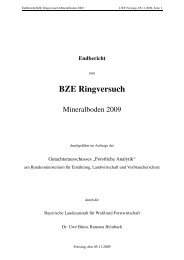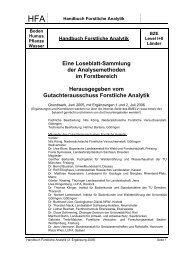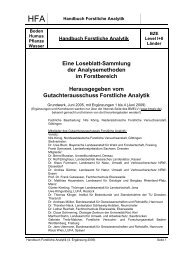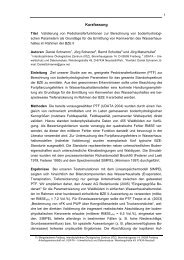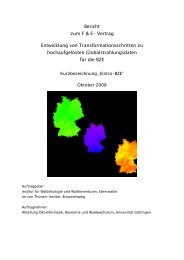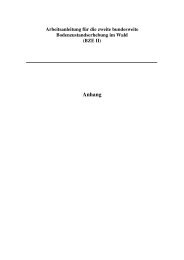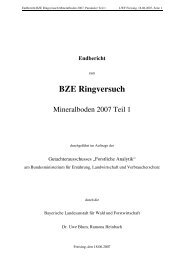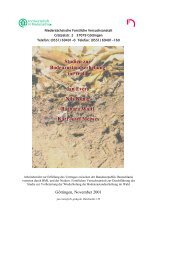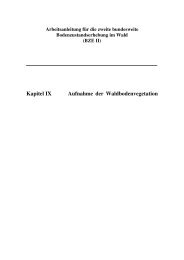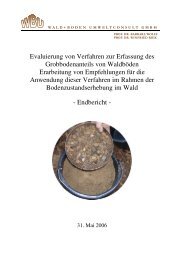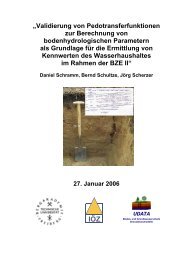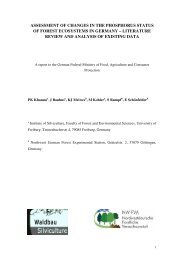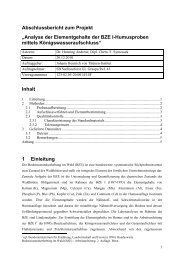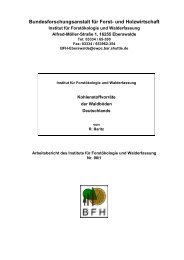assessment of changes in the phosphorus status of forest ...
assessment of changes in the phosphorus status of forest ...
assessment of changes in the phosphorus status of forest ...
Create successful ePaper yourself
Turn your PDF publications into a flip-book with our unique Google optimized e-Paper software.
<strong>the</strong> amount taken up at each site. The <strong>assessment</strong> methods will always provide<br />
values which are optimum and comparable for different sites.<br />
3. A number <strong>of</strong> plant factors such as <strong>the</strong> growth, withdrawal and reuse patterns for P<br />
will determ<strong>in</strong>e <strong>the</strong> amount <strong>of</strong> P required for uptake. For a complete <strong>assessment</strong> <strong>of</strong><br />
P <strong>status</strong> <strong>of</strong> any specific site <strong>the</strong>se factors, which describe <strong>the</strong> flux <strong>of</strong> P through <strong>the</strong><br />
system, should be <strong>in</strong>cluded <strong>in</strong> <strong>the</strong> observation.<br />
4. Forest soils are rich <strong>in</strong> organic matter and mostly highly acid. Any suggested<br />
method should <strong>in</strong>clude <strong>the</strong>se special characteristics <strong>of</strong> <strong>forest</strong> soils.<br />
We have considered different alternatives and have come up with <strong>the</strong> follow<strong>in</strong>g<br />
preferred option <strong>of</strong> a suitable method to study medium to long term <strong>changes</strong> <strong>in</strong> P<br />
<strong>status</strong> <strong>of</strong> <strong>forest</strong> soils <strong>in</strong> Germany.<br />
Desorption <strong>of</strong> soil P by repeated sequential extractions us<strong>in</strong>g an anion based<br />
appropriate extractant<br />
This method is based on <strong>the</strong> common observation that <strong>the</strong> amount <strong>of</strong> P extracted by an<br />
anion based mild extractant (or anion exchange res<strong>in</strong>) provides very low values for P,<br />
which are not related to <strong>the</strong> dynamics <strong>of</strong> P <strong>in</strong> <strong>the</strong> soil. They may provide <strong>in</strong>formation<br />
on short-term P <strong>changes</strong> <strong>in</strong> soils due to fertilization, litter <strong>changes</strong>, soil disturbance<br />
etc. but fail to provide <strong>in</strong>formation on <strong>the</strong> long-term <strong>changes</strong> <strong>in</strong> soil P. Adequate<br />
examples have been provided <strong>in</strong> <strong>the</strong> review to show that. This is primarily due to <strong>the</strong><br />
fact that s<strong>in</strong>gle measurements <strong>of</strong> P pools fail to capture <strong>the</strong> dynamics <strong>of</strong> P desorption<br />
from <strong>the</strong> soils which <strong>in</strong>cludes buffer<strong>in</strong>g capacity <strong>of</strong> labile P and <strong>the</strong> pattern <strong>of</strong> its<br />
release. This can be achieved by repeat<strong>in</strong>g <strong>the</strong> extraction <strong>of</strong> a soil which is carried out<br />
sequentially for sufficient number <strong>of</strong> steps so that <strong>the</strong> rate <strong>of</strong> P release starts to<br />
decrease and sufficient data po<strong>in</strong>ts are available to assess <strong>the</strong> amount <strong>of</strong> desorbable P<br />
and <strong>the</strong> rate <strong>of</strong> desorption. An example <strong>of</strong> such a method is shown <strong>in</strong> Fig 14, where<br />
two <strong>forest</strong> soils were sequentially extracted for a number <strong>of</strong> times us<strong>in</strong>g Bray 1<br />
extractant (commonly used for acid soils) (Serrasolsas et al. <strong>in</strong> review).<br />
As shown <strong>in</strong> Table 11 , <strong>the</strong> two soils were similar <strong>in</strong> many characteristics but<br />
differed significantly <strong>in</strong> P values. Both soils were low <strong>in</strong> P retention capacities. P<br />
fertilisation experiments on <strong>the</strong> two sites showed no growth response <strong>in</strong> one (P<strong>in</strong>us<br />
radiata plantation) but a big response <strong>in</strong> <strong>the</strong> o<strong>the</strong>r (Eucalyptus regrowth) stand. The<br />
pattern <strong>of</strong> P released by stepwise extractions was fitted us<strong>in</strong>g <strong>the</strong> equation y = A (1-e-<br />
Bx ) where y represented <strong>the</strong> cumulative amount desorbed for a cumulative x ml <strong>of</strong><br />
69



